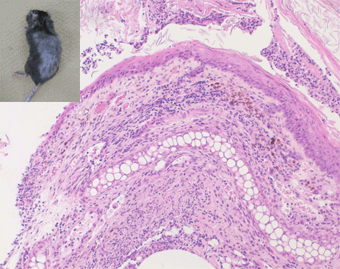T-bet Transgenic Mouse
|
| Development of contact dermatitis in T-bet Transgenic Mouse The histological analysis of the ear skin shows hyperkeratosis, acanthosis, broadening of the papillae, and infiltration of neutrophils lymphocytes, and melanophages similar to what is seen in contact dermatitis in humans. (H & E staining; magnification: x100) In severe case, the transgenic mouse loses hair (left upper). |
Contact dermatitis is a common skin disease caused by a T cell-mediated inflammatory reaction to a foreign antigen. T-bet has been shown as a key molecule for differentiation of Th1 and Tc1 cells which play as effectors in contact dermatitis. The transgenic mice expressed T-bet in T lymphocyte under the control of human CD2 promoter, show dermatitis characterized by swollen, flaky, and scaly skin on the surface of the face, ear, foot and tail. In severe cases, the transgenic mice lose hair all over the body. The mice also have hypersensitive responses to 2,4-dinitrofluorobenzene, which is used for contact hypersensitivity (CHS) in animal models. These transgenic mice can be useful as a model for contact dermatitis.
| Depositor | : | Dr. Satoru Takahashi (University of Tsukuba) |
| Reference | : | J. Immunol. (2007) 178, 605-612. Am. J. Crit. Care. Med. (2006) 174, 142-151. |






